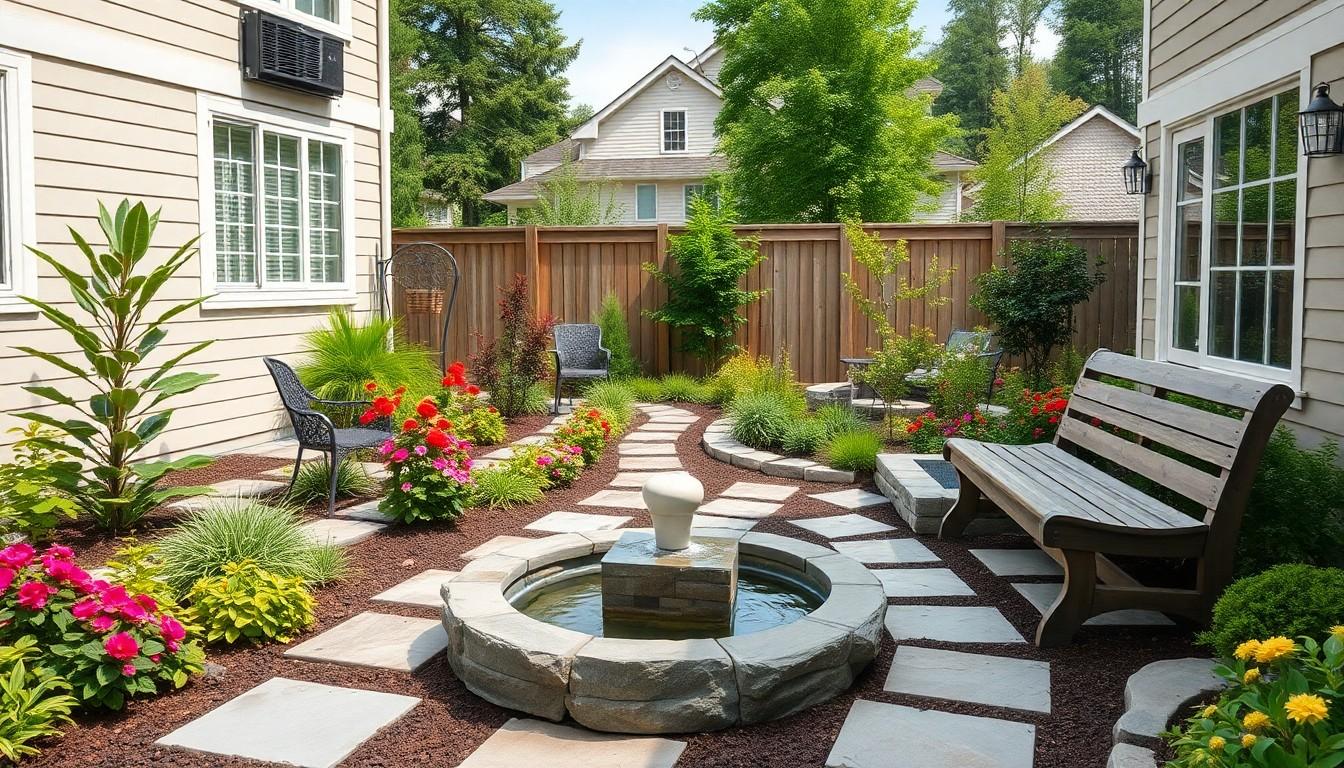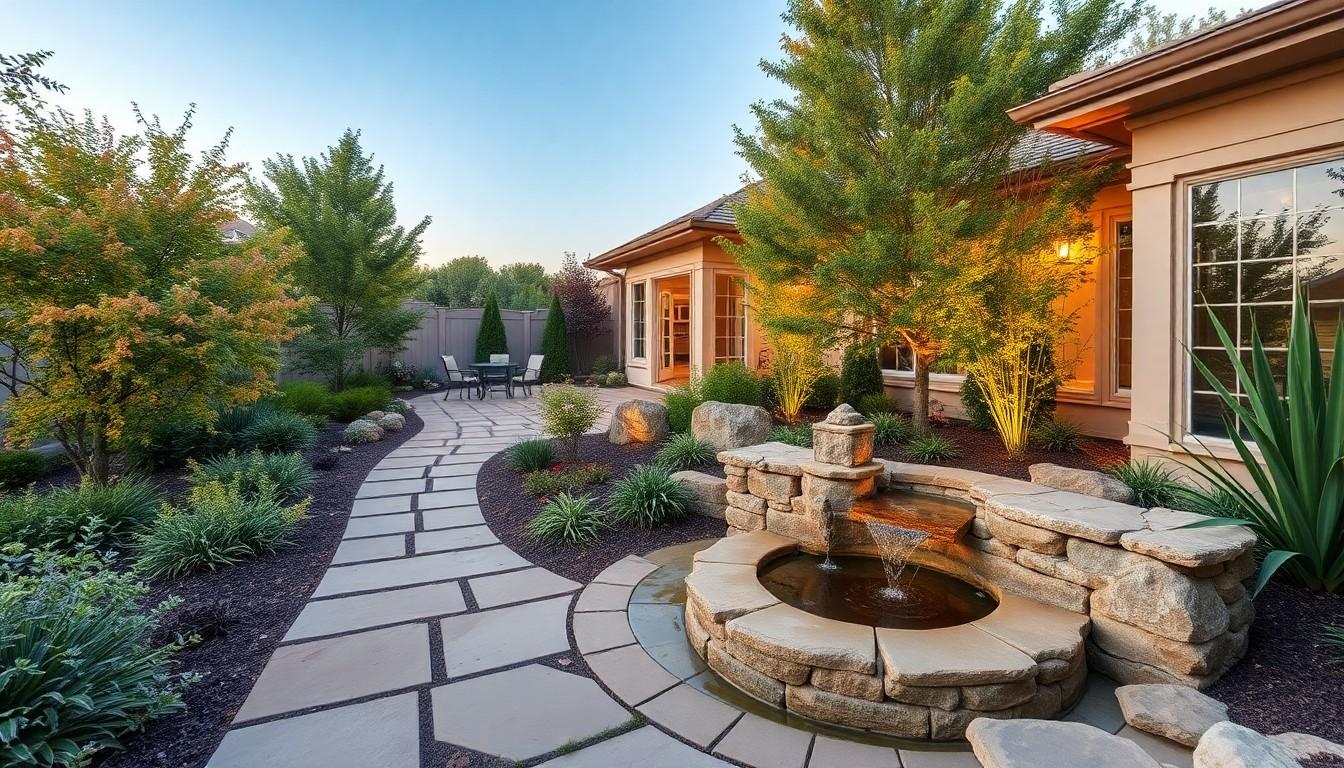Imagine stepping into your backyard and feeling like you’ve just entered a luxurious resort. With the right residential landscape design, that dream can become a reality. It’s not just about pretty flowers and neatly trimmed hedges; it’s about creating an outdoor space that reflects personal style while enhancing the home’s value.
Residential Landscape Design
Residential landscape design creates an outdoor living space that enhances the enjoyment of a home. This design approach balances aesthetics, functionality, and sustainability.
Importance of Landscaping
Landscaping boosts property value, making homes more appealing to potential buyers. A well-designed garden offers a serene environment, promoting relaxation and outdoor activity. Effective landscaping reduces maintenance costs by incorporating native plants that thrive in local climates. Furthermore, it contributes to environmental benefits, such as improved air quality and reduced heat. An individualized landscape design reflects personal style, allowing homeowners to express their creativity outdoors.
Key Elements of Design
Successful landscape design includes essential elements such as plants, hardscapes, water features, and lighting. Plants provide color, texture, and seasonal interest, enhancing the overall appeal. Hardscapes, including patios, walkways, and walls, offer structure and organization to a landscape. Incorporating water features, such as ponds or fountains, creates tranquility and attracts wildlife. Proper lighting enhances safety and highlights key features, allowing enjoyment after sunset. Together, these elements create a cohesive outdoor living space that meets the homeowner’s needs.
Popular Styles in Residential Landscape Design
Residential landscape design encompasses various styles, each reflecting unique aesthetics and ecological approaches. Homeowners often choose from popular options to enhance their outdoor spaces.
Modern Landscaping
Modern landscaping focuses on simplicity and minimalism. Straight lines, geometric shapes, and bold contrasts define this style. Plants often incorporate native species, which thrive in local conditions and reduce maintenance efforts. Hardscaping elements like concrete or stone paths add sleek functionality. Water features, such as sleek fountains or reflective ponds, contribute an artistic touch, enhancing tranquility. Sustainability remains a significant aspect, fostering eco-friendliness while also amplifying visual appeal.
Traditional Landscaping
Traditional landscaping evokes timeless elegance and familiarity. Curvilinear forms and symmetrically designed gardens capture a classic essence. This style often incorporates a variety of flowering plants, shrubs, and trees to create depth and color throughout the seasons. Elements like brick pathways or wooden benches emphasize craftsmanship and comfort. Water features, such as ponds or cascading fountains, enhance the natural beauty of these spaces. Traditional landscapes offer a warm atmosphere, ideal for family gatherings and outdoor enjoyment.
Sustainable Landscaping
Sustainable landscaping emphasizes ecological balance and resource conservation. It prioritizes the use of native plants to support local wildlife and minimize irrigation needs. Organic materials and recycled resources often characterize this style, reducing environmental impact. Rain gardens help manage stormwater, promoting soil health. Incorporating permeable paving and energy-efficient lighting enhances efficiency and sustainability. This approach encourages homeowners to create beautiful spaces while fostering environmental responsibility.
Essential Components of Landscape Design
Successful residential landscape design incorporates several essential components that work together to create an inviting outdoor space. Each element contributes to the overall functionality and aesthetic appeal.
Plant Selection
Selecting the right plants influences the design’s success. Native plants thrive in local climates and require less maintenance. They provide habitat for local wildlife, promote biodiversity, and enhance visual interest. Consider using a combination of trees, shrubs, perennials, and groundcovers. Diverse plant selections can create seasonal color variations and textures. Grouping plants in layers maximizes space, ensuring a lush and vibrant landscape.
Hardscape Elements
Hardscape elements provide structure to the design and include features such as patios, pathways, and retaining walls. These components define areas within the yard and offer durability. Using materials like stone, brick, and concrete can create a timeless look. Incorporate seating areas for relaxation and entertainment. Proper planning ensures hardscapes complement the surrounding greenery, adding functionality without overwhelming the natural landscape.
Water Features
Water features add tranquility and enhance the sensory experience of the landscape. Options include ponds, fountains, and waterfalls, which introduce soothing sounds and attract wildlife. Positioning water features strategically can draw the eye and create focal points. They also improve the overall ecosystem by supporting local flora and fauna. Regular maintenance ensures these features remain appealing and functional throughout the year.
Tips for Effective Residential Landscape Design
Effective residential landscape design requires thoughtful planning and budget considerations. Focusing on these key areas will enhance the overall outcome of the project.
Planning Your Space
Assess the available area before making design choices. Identify existing features like trees and structures that can influence the layout. Consider the desired functions of the space; will it serve as a relaxation zone, entertaining area, or garden? Creating distinct zones can improve organization. Utilize free design tools or hire a landscape professional for a comprehensive plan. Taking these steps promotes a cohesive approach and maximizes the usability of the outdoor area.
Budgeting for Your Project
Establish a clear budget to manage costs effectively. Prioritize essential features, such as planting and hardscapes, over non-essential elements. Research average costs for materials, labor, and maintenance to create a realistic estimate. Allow for contingency funds to address unexpected expenses during the project. Seek estimates from multiple contractors to find the best deals without sacrificing quality. Effective budgeting ensures the ability to achieve landscaping goals without financial strain.
Homeowners
Residential landscape design offers homeowners the opportunity to create stunning outdoor spaces that reflect their personal style and enhance their property’s value. By thoughtfully integrating plants, hardscapes, and water features, individuals can transform their backyards into serene retreats that cater to both aesthetics and functionality.
Embracing various design styles allows for unique expressions of creativity while promoting sustainability through the use of native plants. With careful planning and budgeting, homeowners can develop a landscape that not only meets their needs but also contributes positively to the environment. Investing in residential landscape design is more than just improving curb appeal; it’s about crafting a harmonious outdoor experience that enriches daily life.


